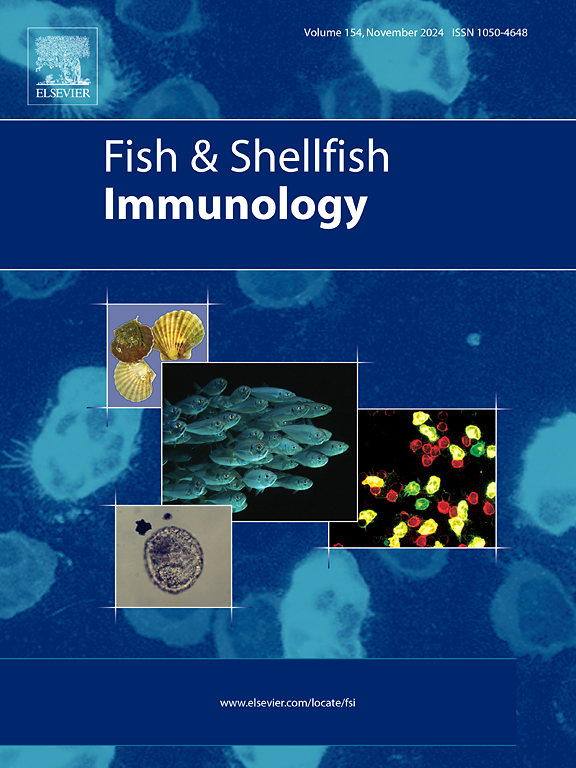基于纳米孔的横滨伪尾柱虫皮肤全长转录组测序发现新型抗菌肽基因。
IF 4.1
2区 农林科学
Q1 FISHERIES
引用次数: 0
摘要
大理石纹比目鱼(Pseudopleuronectes yokohamae)因其特殊的营养价值和美味而备受推崇。然而,该物种的转录组数据极为有限,而这些数据可以为疾病防护提供无价的信息。在这项研究中,使用 Nanopore 测序平台对横滨鲈的皮肤转录组进行测序,发现了 7.72 GB 的纯净数据。研究结果显示,横纹肌藻转录组中有 30,498 个功能注释转录本。所有转录本都在八个功能数据库中进行了搜索。共获得 10,337 个 ORFs,其中 6,081 个完整的 ORFs 占所有预测 CDS 的 58.83%。此外,还检测到 10 195 个 SSR。同时,为了更好地了解横纹肌藻的免疫反应,研究人员还对非特异性免疫途径进行了调查,并确定了七种先天性免疫途径。先天免疫相关基因在 NOD 样受体信号通路中高表达,其次是 C 型凝集素受体信号通路、Toll 样受体信号通路、RIG-I 样受体信号通路和细胞 DNA 传感通路。本研究首次分析了横须贺鲮鱼体内的四个抗菌肽家族,包括鲮鱼素、肝素、肝脏表达抗菌肽和防御素。进一步鉴定了 7 种 AMPs,包括类 Pypleurocidin-like WF3、类 Pypleurocidin-like WFX、Pyhepcidin 1、Pyhepcidin-like 1、PyLEAP-2、Pybeta-防御素和 Pybeta-defensin-like 1。这 7 种 AMPs 的 cDNA 和基因组结构具有高度的一致性,其诱导表达模式更适合皮肤对病原体的反应。这些转录组数据和对横须贺鲤 AMPs 的研究有助于加深对鱼类粘膜免疫的认识,并为鱼类疾病的预防提供信息。本文章由计算机程序翻译,如有差异,请以英文原文为准。
Nanopore-based full-length transcriptome sequencing of the skin in Pseudopleuronectes yokohamae identifies novel antimicrobial peptide genes
The marbled flounder (Pseudopleuronectes yokohamae) is highly esteemed for its exceptional nutritional value and delicious taste. However, this species has extremely limited transcriptome data, which can offer priceless information for disease protection. In the study, the skin transcriptomic sequencing of P. yokohamae revealed 7.72 GB of clean data using the Nanopore sequencing platform. The results revealed 30,498 transcripts of functional annotations in the P. yokohamae transcriptome. All transcripts were searched in eight functional databases. A total of 10,337 ORFs were obtained, of which 6081 complete ORFs accounted for 58.83% of all predicted CDS. Moreover, 10,195 SSRs were detected. Meanwhile, the non-pecific immunity pathways were investigated for better understanding of the immunological reaction in P. yokohamae, and seven innate immune pathways were identified. The innate-immune related genes were highly expressed in the NOD-like receptor signaling pathway, followed by the C-type lectin receptor signaling pathway, Toll-like receptor signaling pathway, RIG-I-like receptor signaling pathway and Cytosolic DNA-sensing pathway. In this study, four families of antimicrobial peptides (AMPs) in P. yokohamae were analysed for the first time, including piscidins, hepcidins, liver-expressed antimicrobial peptide and defensins. Seven AMPs, including Pypleurocidin-like WF3, Pypleurocidin-like WFX, Pyhepcidin 1, Pyhepcidin-like 1, PyLEAP-2, Pybeta-defensin and Pybeta-defensin-like 1, were further identified. The seven AMPs showed a highly identity in their cDNA and genomic structures and an inducible expression pattern preferable to skin in response to pathogens. The transcriptomic data and investigation of AMPs from P. yokohamae promote a deeper awareness of fish mucosal immunity and provide information in the prevention of fish diseases.
求助全文
通过发布文献求助,成功后即可免费获取论文全文。
去求助
来源期刊

Fish & shellfish immunology
农林科学-海洋与淡水生物学
CiteScore
7.50
自引率
19.10%
发文量
750
审稿时长
68 days
期刊介绍:
Fish and Shellfish Immunology rapidly publishes high-quality, peer-refereed contributions in the expanding fields of fish and shellfish immunology. It presents studies on the basic mechanisms of both the specific and non-specific defense systems, the cells, tissues, and humoral factors involved, their dependence on environmental and intrinsic factors, response to pathogens, response to vaccination, and applied studies on the development of specific vaccines for use in the aquaculture industry.
 求助内容:
求助内容: 应助结果提醒方式:
应助结果提醒方式:


